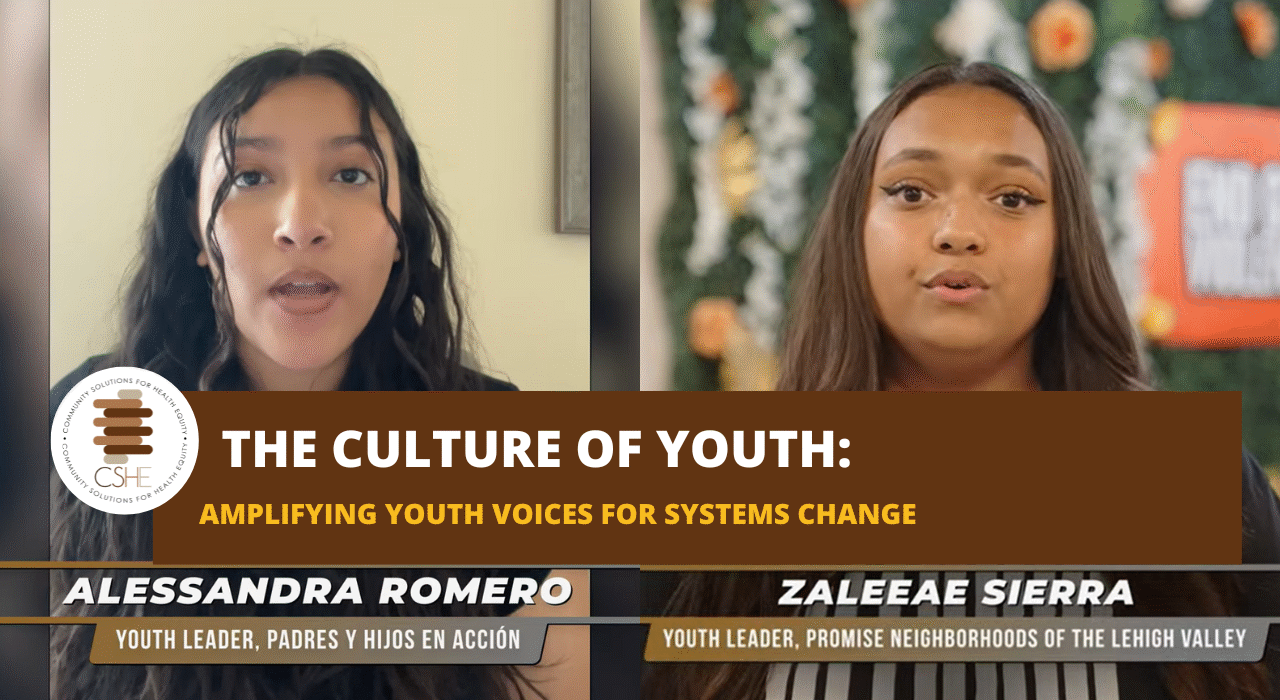When most people think of culture, they picture traditions—foods, dances, languages, spiritual practices—passed from generation to generation. But culture is more than memory. It is also a movement. Culture lives in the present. It evolves, innovates, and responds to the challenges and possibilities of a particular moment in time.
That’s where youth come in.
At CSHE, we believe that to build truly equitable systems, we must embrace culture not just as heritage, but as current, alive, and often led by the bold creativity of young people. We are working to create a collective space where youth voices are not only heard—but centered. Because youth culture isn’t just relevant to our work—it’s essential to it.
“I think it is really important to bring youth culture into CSHE, not only because it is important for youth to be heard, but also because youth is the new generation.” – Alessandra Romero, Youth Leader, Padres y Hijos en Acción
Youth Culture Is Culture
Youth culture is not a sidebar to tradition. It’s not a passing phase. It is a living, breathing expression of how young people interpret and shape the world around them—through language, fashion, music, technology, relationships, and activism. It is how they respond to the injustices they inherit, and how they build new ways forward.
Culture is always tied to its time, and youth are always on the leading edge of that timeline. Their worldview, shaped by the realities they’re growing up in, is the culture of now.
Youth Have Always Led
Youth-led culture and resistance are not new. History is filled with examples of young people transforming their societies:
-
During the French Revolution, students helped lead the charge for freedom.
-
In the U.S., undocumented youth—many of them still in high school or college—launched the immigrant rights movement that led to DACA. Calling themselves “Dreamers,” they organized sit-ins, marches, and bold public actions to demand protections and dignity for their communities.
-
During the Civil Rights Movement, young leaders like John Lewis, only 23 at the time, helped organize sit-ins, Freedom Rides, and voter registration drives as part of the Student Nonviolent Coordinating Committee (SNCC).
These movements were not youth-supported—they were youth-led. And today, we see that same leadership in fights for racial justice, gender equity, climate action, and health care transformation. Young people are not just participating. They are driving the change.
“CSHE is giving that space for us youth to take power and take the initiative to lead conversations about health in our communities.” – Zaleeae Sierra, Youth Director, Promise Neighborhoods of the Lehigh Valley, and CSHE Youth Ambassador
Engaging Youth is About Creating Spaces for their Leadership
We’re not interested in youth engagement as a checkbox. At CSHE, youth are co-creators of our movement for systems change. We are building intentional, culturally affirming spaces where they can lead authentically and safely.
Just last month, CSHE co-sponsored a health equity summit for youth leaders-in Ketchikan Alaska titled Ody S.E.A – Charting a Path to Wellness. The summit was organized by one of CSHE’s funded partner organizations, Ketchikan Wellness Coalition. The CSHE NPO sponsored youth from North Carolina, Pennsylvania, Florida, and Wisconsin to discuss what it means to be a youth leader and how they are involved in the health equity movements in their communities/spaces.
CSHE supported Ketchikan Wellness Coalition (AK) by sponsoring our funded partners youth leaders from West Marion Inc. (NC), Padres e Hijos en Accion (WI), Partnership for Child Health (FL), and Promise Neighborhoods of the Lehigh Valley (PA) with the simple mission of creating a space for them to contribute to the movement towards health equity.
During the three-day summit, youth and adults explored their leadership styles, learned about barriers to access within healthcare systems, and understood how to build their voice – oh, and took some risks by partaking in ziplining! Although the summit began with sessions led by adults, as the event progressed the voices of youth became front and center.
Young people have much to teach, and it is our responsibility to truly listen with intent.
CSHE is Committed to Including and Listening to Young Leaders
Here’s how we’re showing up for youth in our collective work:
-
Creating affirming spaces where youth can show up fully—emotionally, spiritually, and culturally—without judgment.
-
Centering relationships over hierarchy, rejecting adultism and control in favor of mutual respect and collaboration.
-
Uplifting Partner Efforts to Engage and Center Youth Voices
-
Normalizing vulnerability and emotional depth in conversations about health, systems, and care.
-
Elevating youth narratives so they drive how we talk about access, healing, and equity—not as case studies, but as storytellers and strategists.
Youth Leadership Is Not the Future—It’s the Present
Young people are not waiting for permission to lead. They are already doing it—with clarity, creativity, and courage. Our efforts to create truly multicultural spaces within CSHE would be remiss if we did not contemplate Youth Culture and the incredible impact they are having in the movement.
Like John Lewis and the youth leaders who came before them, today’s young people are reshaping systems that were never designed for them. Our role is not to guide from above—it’s to build alongside them. To listen. To learn. And to make room for what they’re creating.
Because youth engagement isn’t an initiative. It’s a cultural shift. And we’re here for it.


